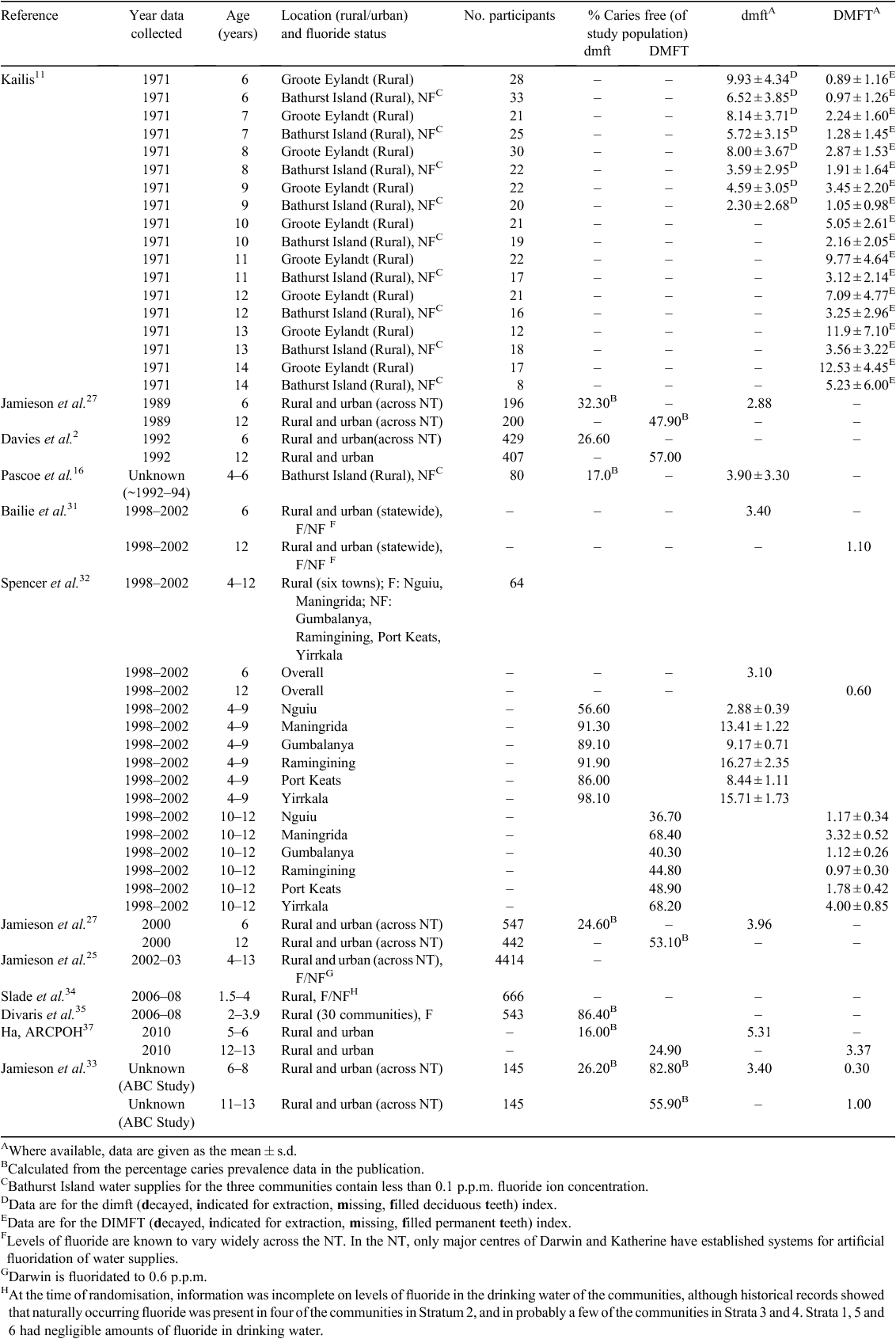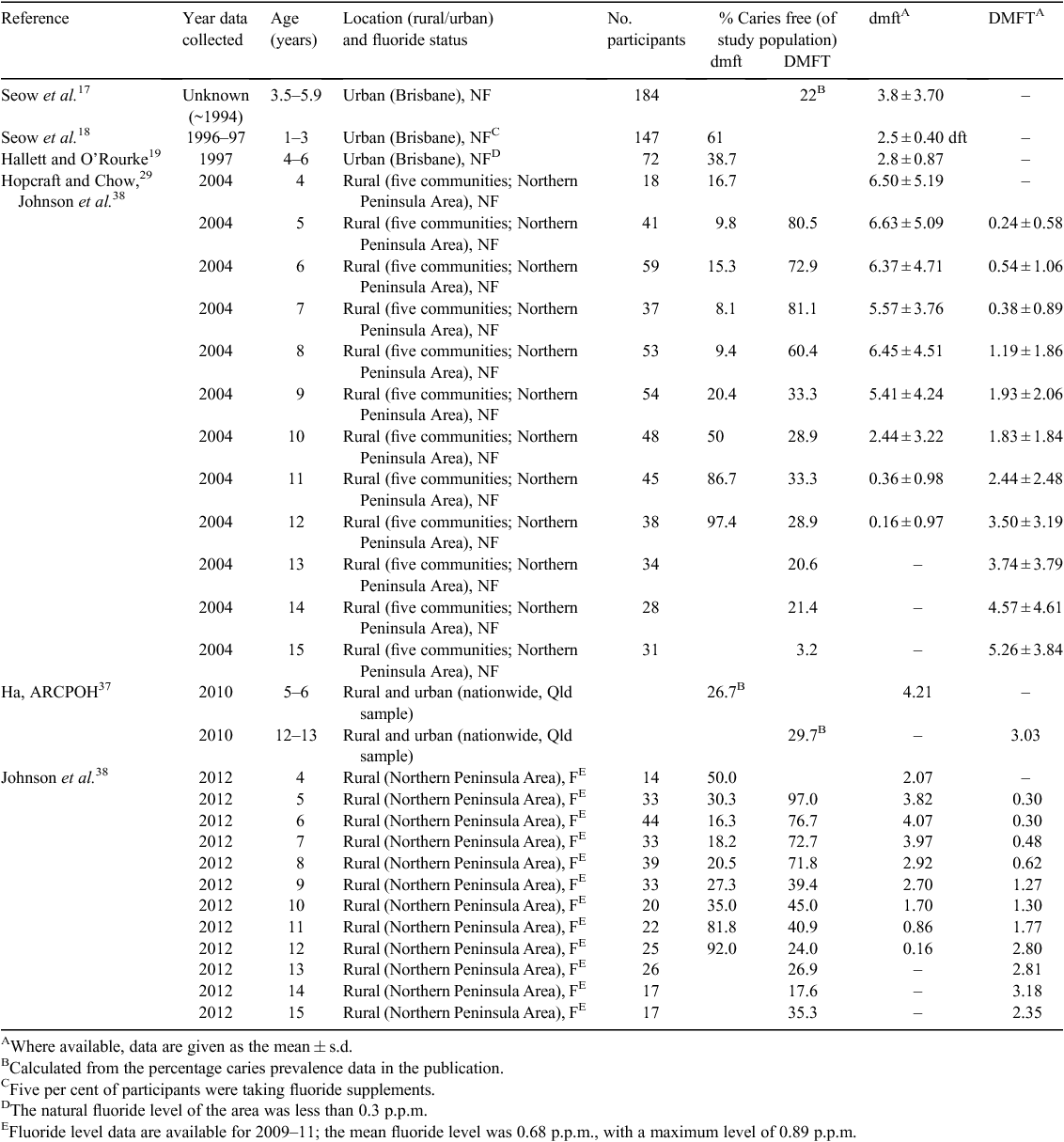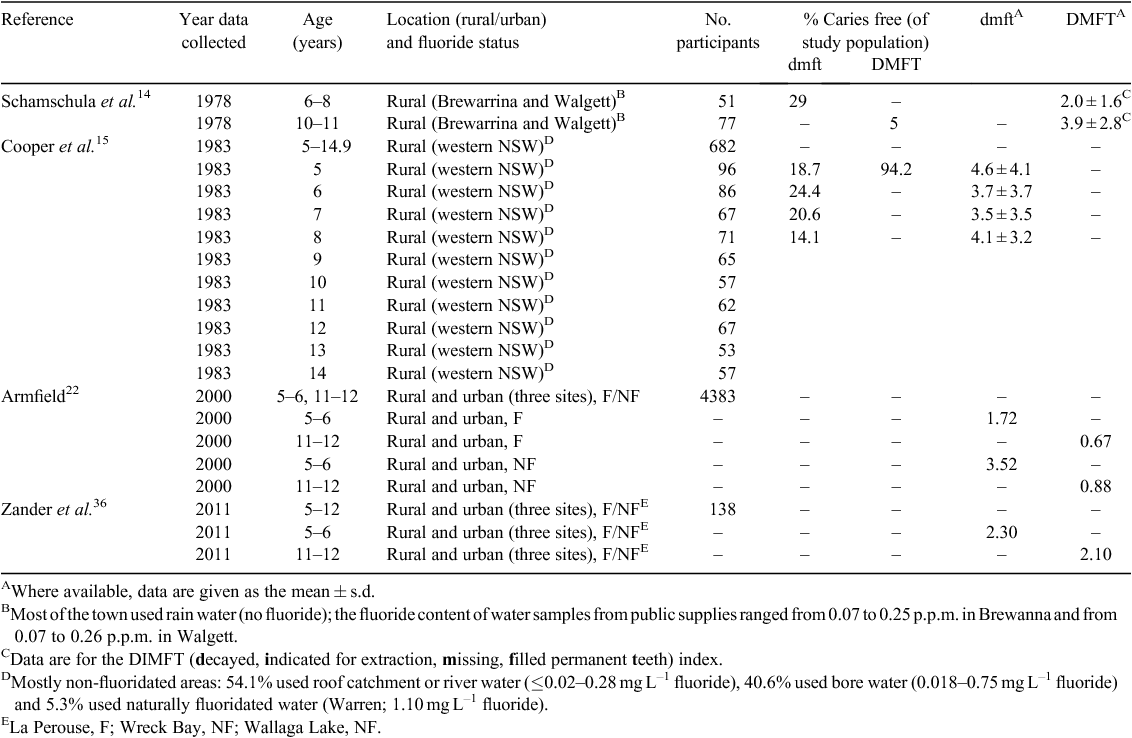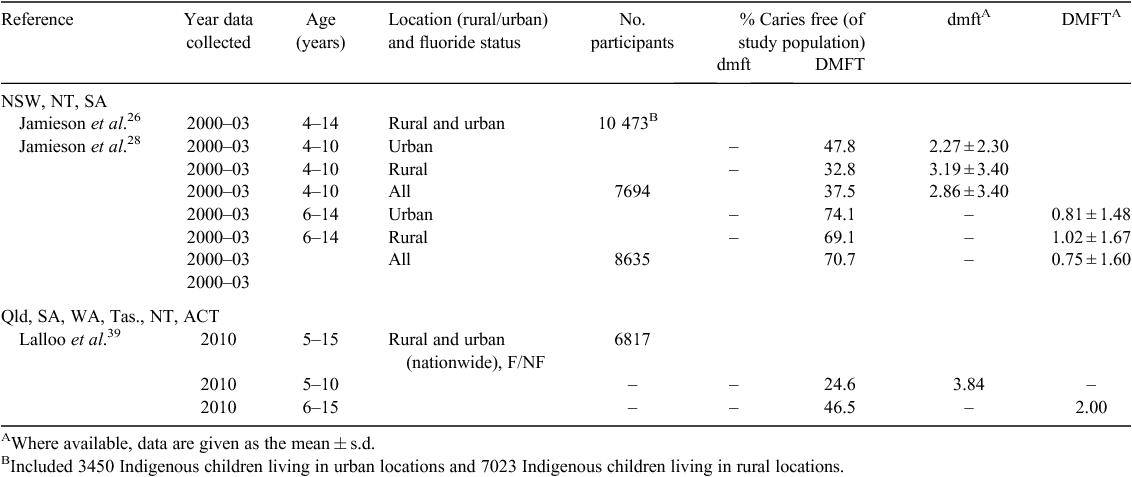Flying blind: trying to find solutions to Indigenous oral health
Andrea M. de Silva A B C , Jacqueline Martin-Kerry A , Alexandra Geale A and Deborah Cole AA Centre of Applied Oral Health Research, Dental Health Services Victoria, 720 Swanston Street, Carlton, Vic. 3053, Australia. Email: jacqueline.martin-kerry@dhsv.org.au; alexandrageale@yahoo.com.au; deborah.cole@dhsv.org.au
B Melbourne Dental School, The University of Melbourne, 720 Swanston Street, Carlton, Vic. 3053, Australia.
C Corresponding author. Email: andrea.desilva@dhsv.org.au
Australian Health Review 40(5) 570-583 https://doi.org/10.1071/AH15157
Submitted: 20 August 2015 Accepted: 29 September 2015 Published: 22 December 2015
Journal Compilation © AHHA 2016
Abstract
Objective The aim of the present study was to identify all published evidence about oral health in Indigenous children in Australia and to determine trends in Indigenous oral health over time.
Methods PubMed was used to search for published peer-reviewed articles that reported caries (decay) prevalence rates and/or caries experience (based on caries indices) in Indigenous children. Studies included in the analysis needed to report clinical oral health data (not self-reported dental experiences), and articles were excluded if they reported caries in only a select, specific or targeted sample (e.g. only children undergoing hospital admissions for dental conditions).
Results The review identified 32 studies that met the inclusion criteria. These studies reported data from the Northern Territory (n = 14), Western Australia (n = 7), South Australia (n = 7), Queensland (n = 7), New South Wales (n = 1), Australian Capital Territory (n = 1) and Tasmania (n = 1). Of the studies, 47% were in rural locations, 9% were in urban locations and 44% were in both rural and urban locations. Data are limited and predominantly for Indigenous children living in rural locations, and there are no published studies on caries in Indigenous children living in Victoria.
Conclusions The present study documents the published prevalence and severity of caries in Indigenous children living in Australia and highlights that limited oral health data are available for this priority population. Although risk factors for oral disease are well known, most of the studies did not analyse the link between these factors and oral disease present. There is also inconsistency in how caries is reported in terms of age and caries criteria used. We cannot rely on the available data to inform the development of policies and programs to address the oral health differences in Indigenous populations living contemporary lives in metropolitan areas.
What is known about the topic? Many studies report that Indigenous people have poorer general health in Australia compared with non-Indigenous people.
What does this paper add? This paper documents the available published prevalence and experience of caries for Indigenous children in Australia. It demonstrates significant limitations in the data, including no Victorian data, inconsistency with reporting methods and most data being for Indigenous children who are living in rural locations.
What are the implications for practitioners? It is important for practitioners to have access to oral health data for Indigenous children in Australia. However, the present study highlights significant knowledge gaps for this population group and identifies ways to collect data in future studies to enable more meaningful comparisons and policy development.
Additional keywords: Aboriginal and Torres Strait Islander, Australia, caries, child, decay, prevalence.
Introduction
Dental caries (dental decay) is a largely preventable disease, but is known to be more common and widespread in Indigenous than non-Indigenous children in Australia.1–3 Oral health is fundamental to both overall health and quality of life and is determined and influenced by a range of socioeconomic, environmental, behavioural, biological and cultural factors.4,5 For children, poor oral health can negatively impact speech, development and learning, sleeping patterns, self-esteem and psychological and social well being.6 Furthermore, poor oral health in childhood tracks into adulthood and has lifelong effects.
The National Oral Health Plan 2004–20137 highlighted Aboriginal and Torres Strait Islander people (within this paper referred to as Indigenous) as a priority population group for targeting improvements in oral health. That document was released in 2003 and recommended several actions to be implemented, including providing culturally appropriate and accessible oral health services through partnerships between mainstream and Indigenous-specific oral health services and improving access to oral hygiene products, such as toothpaste and toothbrushes, for Indigenous people.
Victorian policy identifies Indigenous people as a priority group for accessing public oral healthcare services (https://www2.health.vic.gov.au/primary-and-community-health/dental- health/access-public-dental-services; verified 27 October 2015). It is estimated that 47 333 Indigenous people were residing in Victoria on the 2011 Census night.8 However, little is known about the oral health of Victorian Indigenous people, and it is therefore important to locate and examine existing Australian data to understand the oral health of Indigenous people.
Prior to the 1980s, Indigenous children in Australia were recognised as having better oral health than non-Indigenous children.9 More recently, however, reports suggest that dental decay in Indigenous children is rising,1,10 and decay in deciduous teeth has been estimated to be twice as high as for non-Indigenous children.10 This may be due to the complex interaction of factors such as increased access to processed Western/non-traditional diets, including sweetened drinks, rural location (which can be associated with lack of access to fluoridated water and reduced access to dental services) and social disadvantage. However, data available for Indigenous oral health remains limited. A key action of the National Oral Health Plan 2004–20137 was to improve the collection and quality of oral health information of Indigenous people through regular standardised collection and dissemination of the data. An evidence base is needed to provide an understanding of the oral health needs of Indigenous people living in Australia and to identify ways to close the gap on oral health for this population group.
The aim of the present study was to undertake a review of the peer-reviewed literature and document the published prevalence rates and level of dental caries in Indigenous children to provide a robust evidence base for the purposes of policy and program planning. The review also aimed to investigate the associations between caries and oral health risk factors and to examine studies that reported and compared caries prevalence and severity in Indigenous and non-Indigenous children.
Methods
Search strategy
PubMed was searched independently by two authors (AG and JM-K) using the following search terms: ‘Aboriginal’, ‘Indigenous’, and ‘Torres Strait Islander’ in association with ‘oral health’, ‘oral disease’, ‘rural and remote’, ‘models of care’, ‘primary care’, ‘dental caries’, ‘periodontal disease’, ‘DMFT/dmft’, ‘dental decay’, ‘oral disease prevention’, ‘fluoride’, ‘access to dental services’, ‘dental services’, ‘oral hygiene’, ‘oral health care’ and ‘oral health interventions’. The search had no date limitations and was undertaken between January and September 2014. Only journal articles were included in the present study; no grey literature was searched.
Inclusion and exclusion criteria
Abstracts were reviewed independently by the same two authors (AG and JM-K) to determine whether the papers reported the prevalence, or levels, of caries, periodontal disease or oral cancer in Indigenous children. Following this screening process, full-length articles were retrieved and the inclusion and exclusion criteria were applied. For abstracts where it was unclear whether clinical data were reported, full-length articles were obtained. Studies were included if they measured a clinical outcome obtained during clinical examination of Indigenous children. Clinical outcomes included in the search were caries (decay) and periodontal disease. Papers were excluded if the data they cited were not obtained through a clinical examination (e.g. self-reported dental experience or dental health), if they reported the prevalence of oral disease in dental admission patients only, and not a general population; and if they were reviews.
Data extraction
Data extraction was undertaken by all authors independently and data from each paper was extracted twice by two separate authors. Data extracted included dental caries prevalence and experience, the clinical criteria used for diagnosis, the age of the population sample, study design, year of study, year of data collection and any data looking at risk factors and their effect on oral disease. Caries experience was measured by the decayed, missing and filled teeth index for deciduous/primary teeth (dmft) and for permanent teeth (DMFT). Both indices measure how many teeth (t/T) are decayed (d/D), missing (m/M) or filled (f/F). Caries prevalence data were extracted from the papers. Some studies reported caries prevalence, but most studies reported the proportion of the study population that was caries free. Because of these variations in reporting, the caries-free proportion was calculated from papers that reported caries prevalence (percentage with caries). Data were entered into a Microsoft Excel (Redmond, WA, USA) spreadsheet and examined for any duplication of data in studies by the same authors. Rural and urban location was extracted from papers where this was reported. For those papers that did not report this, an electronic search was undertaken to identify whether the location of the study was rural or urban, and this information was presented in the tables for data completeness. Because of the variation in ages and reporting within the studies, no statistics were undertaken and no trend analysis was possible. Data are reported as presented within the papers included in the study.
Results
Search results
The PubMed searches identified journal articles published from 1971 to October 2014 (including one early access publication, available in September 2014); Fig. 1 documents the search results. The initial search included studies involving Indigenous adults as well as children because of the search terms used. The abstracts were screened and studies were included if they reported clinical oral health information in Australian Indigenous children. For several abstracts it was unclear whether the paper would include clinical oral health data for Indigenous children, and these papers were downloaded for review. Articles were included in the review if they reported clinical dental outcomes determined under clinical examination in Indigenous children in Australia. During this process, it was identified that only one peer-reviewed paper included periodontal disease in Indigenous children; the remainder of papers reported only caries. During the screening process, 32 papers were identified as meeting the criteria for caries prevalence or severity in Indigenous children. The details of these papers are summarised in Table 1.
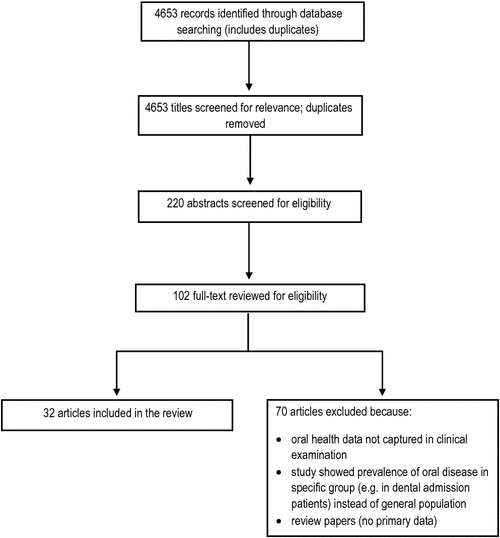
|
Study characteristics
Of the 32 papers included in the study, 9% were published in the 1970s, 6% were published in the 1980s, 13% were published in the 1990s, 44% were published in the 2000s and 28% were published in the current decade. Table 2 summarises the studies by publication date and jurisdiction represented. Twenty-seven of the studies were undertaken in a single jurisdiction; the other five studies looked at the oral health of Indigenous children living in multiple jurisdictions. Two studies involved six jurisdictions, including Tasmania and the Australian Capital Territory (ACT), although one of these studies did not publish data by individual jurisdiction. There were no studies reporting oral health data for Indigenous children living in Victoria. Figure 2 summarises the number of studies publishing data for each jurisdiction, with total Indigenous population numbers.
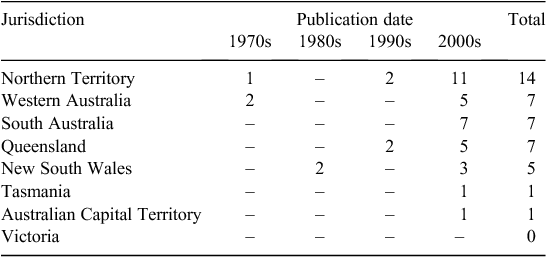
|
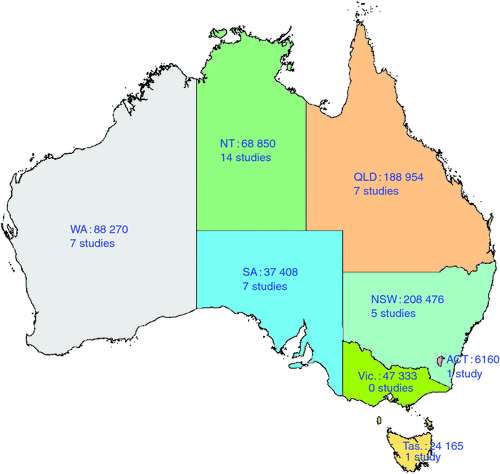
|
Many papers reported oral health data for Indigenous children living in rural areas; some studies reported data across a jurisdiction that included Indigenous children living in rural and metropolitan areas. However, the data reported were generally for that jurisdiction rather than reporting the data by metropolitan or rural/remote locations. Of the studies, 15 were undertaken in rural locations (47%) and three in urban locations (9%). All three studies in urban locations were undertaken in Queensland. The remainder of the studies were undertaken in both rural and urban locations (44%), although only one of these studies reported the data separately by rural and urban location. Fluoridation status was extracted from the papers with the aim of determining whether fluoridation had an effect on the caries experience. However, fluoride information was often not reported or data were not separated by fluoride status. Six studies (19%) reported that the study location was fluoridated, six studies reported the study locations were in non-fluoridated areas (19%), nine studies (28%) reported the study was undertaken in both fluoridated and non-fluoridated locations and 11 studies (34%) did not state the fluoride status of the study’s location.
There was variation in the caries indices used in the studies. The earliest studies used the decayed, extracted, filled teeth and teeth requiring extraction (defx/DEFX) index. One study used the decayed, indicated for extraction, missing, and filled teeth (dimft/DIMFT) index, one study only used the decayed and filled teeth (dft) rather than dmft index and 9% of studies used the significant caries index (SiC) and significant caries index 10 (SiC10), to measure the severity of decay, in addition to dmft/DMFT indices. Approximately one-third of papers reported dmft/DMFT data but did not report which dmft/DMFT index was used. Six papers (19%) did not use a published caries index and either used clinical judgement or visible cavitation in the enamel surface as the measure for decay. The caries data (dmft, DMFT and percentage caries-free data) is tabulated in chronological order by jurisdiction in Tables 3–9.
Most studies did not have a non-Indigenous population included as a comparison group and so we have not presented caries data for non-Indigenous children in this paper.
There was a large variation in how the studies reported oral health data by age. Six studies reported data by single ages of 6 and 12 years and six studies reported data by individual ages ranging between 4 and 15 years or 6 and 14 years. Many studies reported an age range, but there was no consistency with the age range chosen. Age ranges included 0–4, 0–8, 1–3, 1.5–4, 2–4, 2–5, 3.5–5.9, 4–6, 4–9, 5–9, 10–12, 4–13, 5–10, 10–14, <10 and >6 years. Because of this variation, the data for 6- and 12-year-old Indigenous children has been focused on, which are the World Health Organization’s (WHO) benchmark ages.40 Figs 1–4 show the changes in caries and percentage caries-free for 6- and 12-year-old children over time.

|

|
Caries prevalence: 6 year olds
Figs 3 and 4 show the dmft and percentage caries-free data, by jurisdiction, for 6-year-old Indigenous children. When looking at caries levels for 6-year-old children based on all dmft records identified within this study, the proportion of Indigenous children in the 1960s and 1970s who were caries-free was generally much higher than the data suggests is now the case. These data were from rural Western Australia and since that time only one other study has reported caries prevalence data in that state (in 2010). Data collected in 2000 and beyond suggest that the proportion of 6-year-old children who are caries-free is between 15% and 35%. It appears that the proportion of Indigenous children who are caries-free is decreasing in the Northern Territory and Western Australia, although trend analysis was not possible. These two jurisdictions also have the largest number of studies containing caries prevalence.
Data for dmft in 6-year-old children was not conclusive in terms of appearing to trend in dmft scores when looking at all available data across Australia. One study in 1971 (Northern Territory) reported a dmft of 10, whereas most recent studies report a dmft no higher than 6.4, with most ranging between 2 and 5.5. The dmft from Northern Territory showed a decrease between 1971 and 1989, plateauing until 2000, at which time dmft begins to rise again. Other jurisdictions had a small number of studies reporting dmft data and any changes were difficult to determine.
Caries prevalence: 12 year olds
Figures 5 and 6 show the DMFT and percentage caries-free data, by jurisdiction, for 12-year old Indigenous children. For 12-year-old Indigenous children, the proportion of children who were caries-free (based on DMFT) was between 30% and 40%, and this increased to just above 50% in 1992 and 2002. More recent data collected show that 25%–45% of Indigenous 12-year-old children are caries free. When looking at the data by jurisdiction, the percentage of Indigenous 12 year olds in the Northern Territory who are caries free appears to have been similar between 1989 and 2002 but has dropped in 2010. Most jurisdictions had a small number of studies that reported the caries-free proportion, making it difficult to identify any changes over time.

|
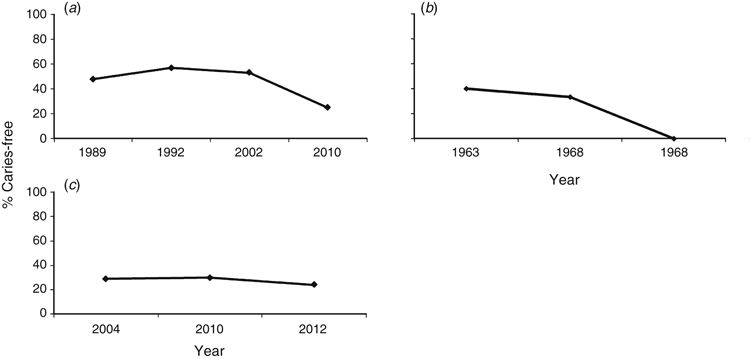
|
DMFT data for 12-year-old Indigenous children showed that the highest reported mean DMFT was collected in Western Australia in 1968; however, two other datasets from Western Australia in 1963 and 1968 reported a much lower DMFT. Generally, 12-year-old Indigenous children in the Northern Territory have higher mean DMFT scores; recent DMFT data for this age group (studies in South Australia and Queensland) suggest DMFT scores of between 1 and 4.
Discussion
Both nationally and within state policy, Indigenous people are a priority group for public oral health.7 In order to develop oral health policy and improve the oral health of Indigenous people, we wanted to identify all available oral health data in peer-reviewed journals for Indigenous children to determine the level of oral disease and whether there was an association between oral health risk factors and oral disease. The present review documents the dental caries data, collected under clinical examination conditions, for Indigenous children published in the peer-reviewed literature to October 2014. The present review has identified that limited data exist for the oral health of Indigenous children living throughout Australia. It also identifies inconsistencies in data captured and reporting that limits meaningful comparisons and analysis.
It is known that approximately 670 000 Indigenous people, or 3% of the Australian population, reside throughout Australia,8 and many live in metropolitan locations. However, this review identified that most studies reported the oral health of Indigenous children living in rural and remote locations. There is a need for more data on the oral health of Indigenous children living in urban areas. Studies that look at the oral health of children living in rural and urban locations need to report the data by location (rural, remote and metropolitan) so that it can be determined whether there are differences in the oral health of Indigenous children living in these locations. Of significant interest is the absence of any oral health data for Indigenous children living in Victoria. This is an important gap to identify because it known that more than 47 000 Indigenous people live in Victoria;8 however, no oral health data have been published in the scientific literature for Indigenous children living within the state.
It was not possible to undertake trend analysis, or any other statistical analysis, on the data extracted because of reporting inconsistencies. Some studies did not even report the year that the data were collected. Data were reported variously be age bands (e.g. 1–3, 5–9 years) or by a single age. Often the studies only reported within an age range and not by the individual age, although in most cases it appears that this would have been possible for the authors to report. When collating and comparing the data, it was extremely difficult to find enough data for a particular age to allow meaningful comparisons. In an attempt to examine trends, we chose the WHO recommended ages of 6 and 12 years to compare the existing data. Only some of the studies reported data for these two time points. There were more data available for 6- than for 12-year-old Indigenous children. For 6-year-old children, the percentage of children who are caries free appears to decrease over time. However, the earlier studies in the 1960s were undertaken in remote locations in Western Australia.11–13 The mean dmft data for 6 year olds appears to remain relatively constant across the time points apart from two studies showing that the dmft was above 6.11,29 Data analysis for 12-year-old Indigenous children was difficult because available data from jurisdictions were limited and most jurisdictions did not have DMFT or caries-free data across a range of time points.
An inconsistency identified through the present review was the wide variation in the methods and caries indices used to measure and report dental caries, and the variations in reporting of Indigenous oral health data. This limits our ability to assess the data and make meaningful comparisons between studies and time points. Another important finding from the present review is that although risk factors for oral health are well established in the general population, very few of the studies included in this analysis have actually measured the known risk factors and examined the associations with caries in Indigenous children. Some of the papers did discuss the risk factors known to lead to poorer oral health, but did not attempt to measure the relationship between these risk factors and the development of caries. Reporting only the prevalence of oral disease does not assist in developing solutions and it is time that we go beyond simply describing the disease. The authors are aware of several intervention trials,41,42 but these are limited in number and applicability to the context of Indigenous people living in metropolitan and regional communities.
Conclusions
The present review highlights that despite Indigenous people being a priority group for the public oral health care system, we actually do not have robust statistics to inform future activities. Because of variations in data capture, limited numbers of studies and the different age groups studied, comparisons are impossible to make.
For future research into Indigenous child oral health, we recommend the following:
-
consistency in the reporting of caries data in relation to child age, study location (including whether rural or urban; and fluoridation status)
-
more data are collected for Indigenous children living in metropolitan and regional areas of Australia
-
data for Indigenous children living in Victoria are collected and reported to enable evidence-based decision making in relation to policy and program development
-
studies examining oral health inequities include risk factor analysis within the design
-
studies go further than simply describing oral disease, and undertake a more sophisticated exploration of the issues involved, and explore possible solutions.
Competing interests
The authors have no competing interests to declare.
Acknowledgements
The authors thank Dr Bradley Christian for undertaking some of the data extraction and Dr Martin Whelan for preparation of the map.
References
[1] Jamieson LM, Parker EJ, Armfield JM. Indigenous child oral health at a regional and state level. J Paediatr Child Health 2007; 43 117–21.| Indigenous child oral health at a regional and state level.Crossref | GoogleScholarGoogle Scholar | 17316183PubMed |
[2] Davies MJ, Spencer AJ. Dental caries among Australian Aboriginal, non-Aboriginal Australian-born, and overseas-born. Bull World Health Organ 1997; 75 197–203.
| 1:STN:280:DyaK2svit12nsw%3D%3D&md5=ee0c4d203226b95c13f7fe26e92f5ce7CAS | 9277006PubMed |
[3] Dogar F, Kruger E, Dyson K, Tennant M. Oral health of pre-school children in rural and remote Western Australia. Rural Remote Health 2011; 11 1–7.
[4] Vanobbergen J, De Visschere L, Daems M, Ceuppens A, Van Emelen J. Sociodemographic determinants for oral health risk profiles. Int J Dent 2010; 2010 article ID938936
| Sociodemographic determinants for oral health risk profiles.Crossref | GoogleScholarGoogle Scholar |
[5] Watt RG, Sheiham A. Integrating the common risk factor approach into a social determinants framework. Community Dent Oral Epidemiol 2012; 40 289–96.
| Integrating the common risk factor approach into a social determinants framework.Crossref | GoogleScholarGoogle Scholar | 22429083PubMed |
[6] Kramer PF, Feldens CA, Ferreira SH, Bervian J, Rodrigues PH, Peres MA. Exploring the impact of oral diseases and disorders on quality of life of preschool children. Community Dent Oral Epidemiol 2013; 41 327–35.
| Exploring the impact of oral diseases and disorders on quality of life of preschool children.Crossref | GoogleScholarGoogle Scholar | 23330729PubMed |
[7] National Advisory Committee on Oral Health. Healthy mouths healthy lives: Australia’s national oral health plan 2004–2013. Adelaide: South Australian Department of Health; 2004.
[8] Australian Bureau of Statistics. Estimates of Aboriginal and Torres Strait Islander Australians, June 2011. 2011. Available at: http://www.abs.gov.au/ausstats/abs@.nsf/mf/3238.0.55.001 [verified 12 June 2015].
[9] Harford JSJ, Roberts-Thomson K. Oral health. In Thomson N, editor. The health of Indigenous Australians. Melbourne: Oxford University Press; 2003. pp. 313–38.
[10] Christian B, Blinkhorn AS. A review of dental caries in Australian Aboriginal children: the health inequalities perspective. Rural Remote Health 2012; 12 2032
| 23098560PubMed |
[11] Kailis DG. Australian Aboriginal studies. 1. The effect of socio-economic changes on the prevalence of caries in 6–14 year-old children resident at Bathurst Island and Groote Eylandt in the Northern Territory of Australia, 1971. Aust Dent J 1979; 24 363–8.
| Australian Aboriginal studies. 1. The effect of socio-economic changes on the prevalence of caries in 6–14 year-old children resident at Bathurst Island and Groote Eylandt in the Northern Territory of Australia, 1971.Crossref | GoogleScholarGoogle Scholar | 1:STN:280:DyaL3c7gvVymsQ%3D%3D&md5=0b9d71e4ef3914b4b4dfae6ea4991013CAS | 294243PubMed |
[12] Kailis DG. Dental conditions observed in Australian aboriginal children resident in Warburton and Cundeelee missions, Western Australia (August, 1968). Aust Dent J 1971; 16 44–52.
| Dental conditions observed in Australian aboriginal children resident in Warburton and Cundeelee missions, Western Australia (August, 1968).Crossref | GoogleScholarGoogle Scholar | 1:STN:280:DyaE3M7mtFOksQ%3D%3D&md5=5a7fd81d27efbe72d70acda768c910cbCAS | 4396468PubMed |
[13] Kailis DG, Silva DG. Prevalence of dental caries in Australian aboriginal children resident in Carnarvon, Western Australia. Aust Dent J 1971; 16 109–15.
| Prevalence of dental caries in Australian aboriginal children resident in Carnarvon, Western Australia.Crossref | GoogleScholarGoogle Scholar | 1:STN:280:DyaE3M3jslKrsQ%3D%3D&md5=def6d78d4585cd01a40645a948da7a70CAS | 4397553PubMed |
[14] Schamschula RG, Cooper MH, Adkins BL, Barmes DE, Agus HM. Oral conditions in Australian children of Aboriginal and Caucasian descent. Community Dent Oral Epidemiol 1980; 8 365–9.
| Oral conditions in Australian children of Aboriginal and Caucasian descent.Crossref | GoogleScholarGoogle Scholar | 1:STN:280:DyaL3M7js1yhtw%3D%3D&md5=ae8a4d4c46f6c871cca9edd384a6f9b5CAS | 6937283PubMed |
[15] Cooper MH, Schamschula RG, Craig GG. Caries experience of Aboriginal children in the Orana region of New South Wales. Aust Dent J 1987; 32 292–4.
| Caries experience of Aboriginal children in the Orana region of New South Wales.Crossref | GoogleScholarGoogle Scholar | 1:STN:280:DyaL1c%2Fns1Kitg%3D%3D&md5=1a6631b3ce7035c277b4cc5fbe21e701CAS | 3479968PubMed |
[16] Pascoe L, Seow WK. Enamel hypoplasia and dental caries in Australian aboriginal children: prevalence and correlation between the two diseases. Pediatr Dent 1994; 16 193–9.
| 1:STN:280:DyaK2czjs1Cnuw%3D%3D&md5=451524fb94655d9d507c5db529001459CAS | 8058543PubMed |
[17] Seow WK, Amaratunge A, Bennett R, Bronsch D, Lai PY. Dental health of Aboriginal pre-school children in Brisbane, Australia. Community Dent Oral Epidemiol 1996; 24 187–90.
| Dental health of Aboriginal pre-school children in Brisbane, Australia.Crossref | GoogleScholarGoogle Scholar | 1:STN:280:DyaK2s%2FisVOqsQ%3D%3D&md5=9d8976196d9f75bfe8852d01217d966eCAS | 8871017PubMed |
[18] Seow WK, Amaratunge A, Sim R, Wan A. Prevalence of caries in urban Australian aborigines aged 1–3.5 years. Pediatr Dent 1999; 21 91–6.
| 1:STN:280:DyaK1M3htlSrsw%3D%3D&md5=1528862c706d64389945c8aabb6c7bdbCAS | 10197332PubMed |
[19] Hallett KB, O’Rourke PK. Early childhood caries and infant feeding practice. Community Dent Health 2002; 19 237–42.
| 12489838PubMed |
[20] Roberts-Thomson K. Oral health of Aboriginal Australians. Aust Dent J 2004; 49 151–3.
| Oral health of Aboriginal Australians.Crossref | GoogleScholarGoogle Scholar | 15497360PubMed |
[21] Endean C, Roberts-Thomson K, Wooley S. Anangu oral health: the status of the Indigenous population of the Anangu Pitjantjatjara lands. Aust J Rural Health 2004; 12 99–103.
| Anangu oral health: the status of the Indigenous population of the Anangu Pitjantjatjara lands.Crossref | GoogleScholarGoogle Scholar | 15200519PubMed |
[22] Armfield JM. Public water fluoridation and dental health in New South Wales. Aust N Z J Public Health 2005; 29 477–83.
| Public water fluoridation and dental health in New South Wales.Crossref | GoogleScholarGoogle Scholar | 16255452PubMed |
[23] Blair EM, Zubrick SR, Cox AH. The Western Australian Aboriginal Child Health Survey: findings to date on adolescents. Med J Aust 2005; 183 433–5.
| 16225453PubMed |
[24] Kruger E, Dyson K, Tennant M. Pre-school child oral health in rural Western Australia. Aust Dent J 2005; 50 258–62.
| Pre-school child oral health in rural Western Australia.Crossref | GoogleScholarGoogle Scholar | 1:STN:280:DC%2BD28roslSisQ%3D%3D&md5=1f444ab59af6be0fa9e582165276daf7CAS | 17016892PubMed |
[25] Jamieson LM, Armfield JM, Roberts-Thomson KF. Oral health inequalities among Indigenous and nonindigenous children in the Northern Territory of Australia. Community Dent Oral Epidemiol 2006; 34 267–76.
| Oral health inequalities among Indigenous and nonindigenous children in the Northern Territory of Australia.Crossref | GoogleScholarGoogle Scholar | 16856947PubMed |
[26] Jamieson LM, Armfield JM, Roberts-Thomson KF. The role of location in Indigenous and non-Indigenous child oral health. J Public Health Dent 2006; 66 123–30.
| The role of location in Indigenous and non-Indigenous child oral health.Crossref | GoogleScholarGoogle Scholar | 16711632PubMed |
[27] Jamieson LM, Armfield JM, Roberts-Thomson KF. Dental caries trends among Indigenous and non-Indigenous Australian children. Community Dent Health 2007; 24 238–46.
| 1:STN:280:DC%2BD1c%2FptVWrtg%3D%3D&md5=d85a3f2f9429c3a06b6c9a0d1b78789eCAS | 18246842PubMed |
[28] Jamieson LM, Armfield JM, Roberts-Thomson KF. Indigenous and non-Indigenous child oral health in three Australian states and territories. Ethn Health 2007; 12 89–107.
| Indigenous and non-Indigenous child oral health in three Australian states and territories.Crossref | GoogleScholarGoogle Scholar | 17132586PubMed |
[29] Hopcraft M, Chow W. Dental caries experience in Aboriginal and Torres Strait Islanders in the Northern Peninsula Area, Queensland. Aust Dent J 2007; 52 300–4.
| Dental caries experience in Aboriginal and Torres Strait Islanders in the Northern Peninsula Area, Queensland.Crossref | GoogleScholarGoogle Scholar | 1:STN:280:DC%2BD1c7gvVaiuw%3D%3D&md5=415c906908547cebc533ff977b4ebf22CAS | 18265686PubMed |
[30] Parker EJ, Jamieson LM. Oral health comparisons between children attending an Aboriginal health service and a government school dental service in a regional location. Rural Remote Health 2007; 7 625
| 17474830PubMed |
[31] Bailie RS, Stevens M, Armfield JM, Ehsani JP, Beneforti M, Spencer J. Association of natural fluoride in community water supplies with dental health of children in remote Indigenous communities: implications for policy. Aust N Z J Public Health 2009; 33 205–11.
| Association of natural fluoride in community water supplies with dental health of children in remote Indigenous communities: implications for policy.Crossref | GoogleScholarGoogle Scholar | 19630837PubMed |
[32] Spencer AJ, Bailie R, Jamieson L. The Strong Teeth Study; background, rationale and feasibility of fluoridating remote Indigenous communities. Int Dent J 2010; 60 250–6.
| 1:STN:280:DC%2BC3cjlvVejsg%3D%3D&md5=eed1dca6b79309b9a1c6ba5db982bf4cCAS | 20718312PubMed |
[33] Jamieson LM, Armfield JM, Roberts-Thomson KF, Sayers SM. A retrospective longitudinal study of caries development in an Australian Aboriginal birth cohort. Caries Res 2010; 44 415–20.
| A retrospective longitudinal study of caries development in an Australian Aboriginal birth cohort.Crossref | GoogleScholarGoogle Scholar | 1:STN:280:DC%2BC3cjpsFSrsg%3D%3D&md5=ff16cd6c28c3bebd2aa1bb71b7684519CAS | 20720421PubMed |
[34] Slade GD, Bailie RS, Roberts-Thomson K, Leach AJ, Raye I, Endean C, Simmons B, Morris PS. Effect of health promotion and fluoride varnish on dental caries among Australian Aboriginal children: results from a community-randomized controlled trial. Community Dent Oral Epidemiol 2011; 39 29–43.
| Effect of health promotion and fluoride varnish on dental caries among Australian Aboriginal children: results from a community-randomized controlled trial.Crossref | GoogleScholarGoogle Scholar | 20707872PubMed |
[35] Divaris K, Preisser JS, Slade GD. Surface-specific efficacy of fluoride varnish in caries prevention in the primary dentition: results of a community randomized clinical trial. Caries Res 2013; 47 78–87.
| Surface-specific efficacy of fluoride varnish in caries prevention in the primary dentition: results of a community randomized clinical trial.Crossref | GoogleScholarGoogle Scholar | 1:CAS:528:DC%2BC3sXhslWisr0%3D&md5=cc1d06f2994d9d77ce607750a6d5214dCAS | 23207237PubMed |
[36] Zander A, Sivaneswaran S, Skinner J, Byun R, Jalaludin B. Risk factors for dental caries in small rural and regional Australian communities. Rural Remote Health 2013; 13 1–9.
[37] Ha D, Australian Research Centre for Population Oral Health Oral health of Australian Indigenous children compared to non-Indigenous children enrolled in school dental services. Aust Dent J 2014; 59 395–400.
| Oral health of Australian Indigenous children compared to non-Indigenous children enrolled in school dental services.Crossref | GoogleScholarGoogle Scholar | 25040876PubMed |
[38] Johnson N, Lalloo R, Kroon J, Fernando S, Tut O. Effectiveness of water fluoridation in caries reduction in a remote Indigenous community in Far North Queensland. Aust Dent J 2014; 59 366–71.
| Effectiveness of water fluoridation in caries reduction in a remote Indigenous community in Far North Queensland.Crossref | GoogleScholarGoogle Scholar | 1:STN:280:DC%2BC2cjitVSjsw%3D%3D&md5=9597f59f154d8c67a09fd73b3d57e53dCAS | 24820049PubMed |
[39] Lalloo R, Jamieson LM, Ha D, Ellershaw A, Luzzi L. Does fluoride in the water close the dental caries gap between Indigenous and non-Indigenous children? Aust Dent J 2014; 60 390–6.
| Does fluoride in the water close the dental caries gap between Indigenous and non-Indigenous children?Crossref | GoogleScholarGoogle Scholar |
[40] World Health Organization. Oral health surveys – basic methods, 5th edition. Geneva: WHO; 2012.
[41] Blinkhorn F, Brown N, Freeman R, Humphris G, Martin A, Blinkhorn A. A phase II clinical trial of a dental health education program delivered by aboriginal health workers to prevent early childhood caries. BMC Public Health 2012; 12 681
| A phase II clinical trial of a dental health education program delivered by aboriginal health workers to prevent early childhood caries.Crossref | GoogleScholarGoogle Scholar | 22909327PubMed |
[42] Merrick J, Chong A, Parker E, Roberts-Thomson K, Misan G, Spencer J, Broughton J, Lawrence H, Jamieson L. Reducing disease burden and health inequalities arising from chronic disease among Indigenous children: an early childhood caries intervention. BMC Public Health 2012; 12 323
| Reducing disease burden and health inequalities arising from chronic disease among Indigenous children: an early childhood caries intervention.Crossref | GoogleScholarGoogle Scholar | 22551058PubMed |



